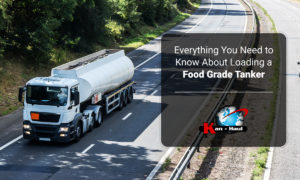February 14, 2020
Everything You Need to Know About Loading a Food Grade Tanker
 How can you trust that your products will be well-handled when you’re hiring food transport? With cross-contamination and spoiled goods being a major fear in the food industry, it’s only natural to be worried.
How can you trust that your products will be well-handled when you’re hiring food transport? With cross-contamination and spoiled goods being a major fear in the food industry, it’s only natural to be worried.
Thankfully, there’s a way to combat this fear. As long as you understand the loading and unloading process of a food grade tanker, you’ll be able to relax while you wait for your next delivery.
Read on to learn more and gain a better understanding of the loading process.
What Are the Requirements to Load a Food Grade Tanker?
Before the loading process can even start, there are some requirements that the plant personnel and driver must fulfill to guarantee product safety:
- The tanker’s access points should have tamper-proof seals from the wash center. This includes a vent cap, dome cover, tank outlet, pump inlet, pump outlet, and hose tubes.
- The driver should have the wash certificate as proof that the tanker is clean.
- The plant personnel should record all the documents and seal numbers.
- The tanker should be inspected and no odors should be coming from the tanker as a result of previous cargo.
Once these standards are met, the loading can begin.
The Process of Loading a Food Grade Tanker
There are several steps that are followed when packing a food grade tanker to ready for transport. They are:
Step 1
The tanker driver arrives at the loading location. He should ensure that the loading area is clean and free of debris, as this guarantees no risk of contamination. All workers should also wear all the safety gear as required by the rules.
Step 2
The actual loading begins. There are two methods that a driver can use to load (or unload) a food grade tanker: air pressure or roper pump. Regardless of the choice, a hose and pump is connected to the access point after breaking the wash seals. This creates suction to help with the loading process.
Step 3
The driver pressurizes the hoses to confirm that there are no leaks. If there is a bad gasket or a bad valve on the customer’s side, the driver will be able to notice and handle it based on the company’s policy.
Step 4
The next step is to open the valve and start the pump. However, all connections must be rechecked and confirmed that they are properly secured. After starting the pump, the driver opens the tanker valves slowly and begins to fill the tank.
Step 5
The driver will do a final check for any leaks. They will ensure that the cam locks have secured properly to avoid vibrations, spills, or movement of the product.
The entire process takes about one to one and a half hours to complete.
Post-Loading Checks
The tanker should once again be closed with tamper-proof seals to ensure there is no contamination during the transport process.
The plant personnel and driver records the seal numbers on the appropriate documentation, such as the bill of lading. It should have the food name or be otherwise identified by DOT regulations.
The Process of Unloading a Food Grade Tanker
Once the tanker arrives at the destination, the receiver checks and confirms the cargo and seal numbers.
The receiver will also check the wash ticket copy to confirm the prior load. If there is any contradiction with the current material, the receiver notifies the management.
When all of the documents are in order, the receiver examines the tanker equipment including the hoses and pumps.
After everything checks out, the tanker is unloaded and the product distributed accordingly.
Use a Food Grade Tanker to Transport Your Goods
A food grade tanker company must fulfill all the safety and hygiene regulations to ensure your products arrive safe and clean. All workers involved in the process follow strict protocol to ensure safe handling of the cargo. With these regulations in place, you can have peace of mind knowing that your products are in good hands.
Kan-Haul has been part of the alcohol transport industry for the last three decades, offering satisfaction with every delivery. Contact us today and let us help with your food grade tanker needs.
